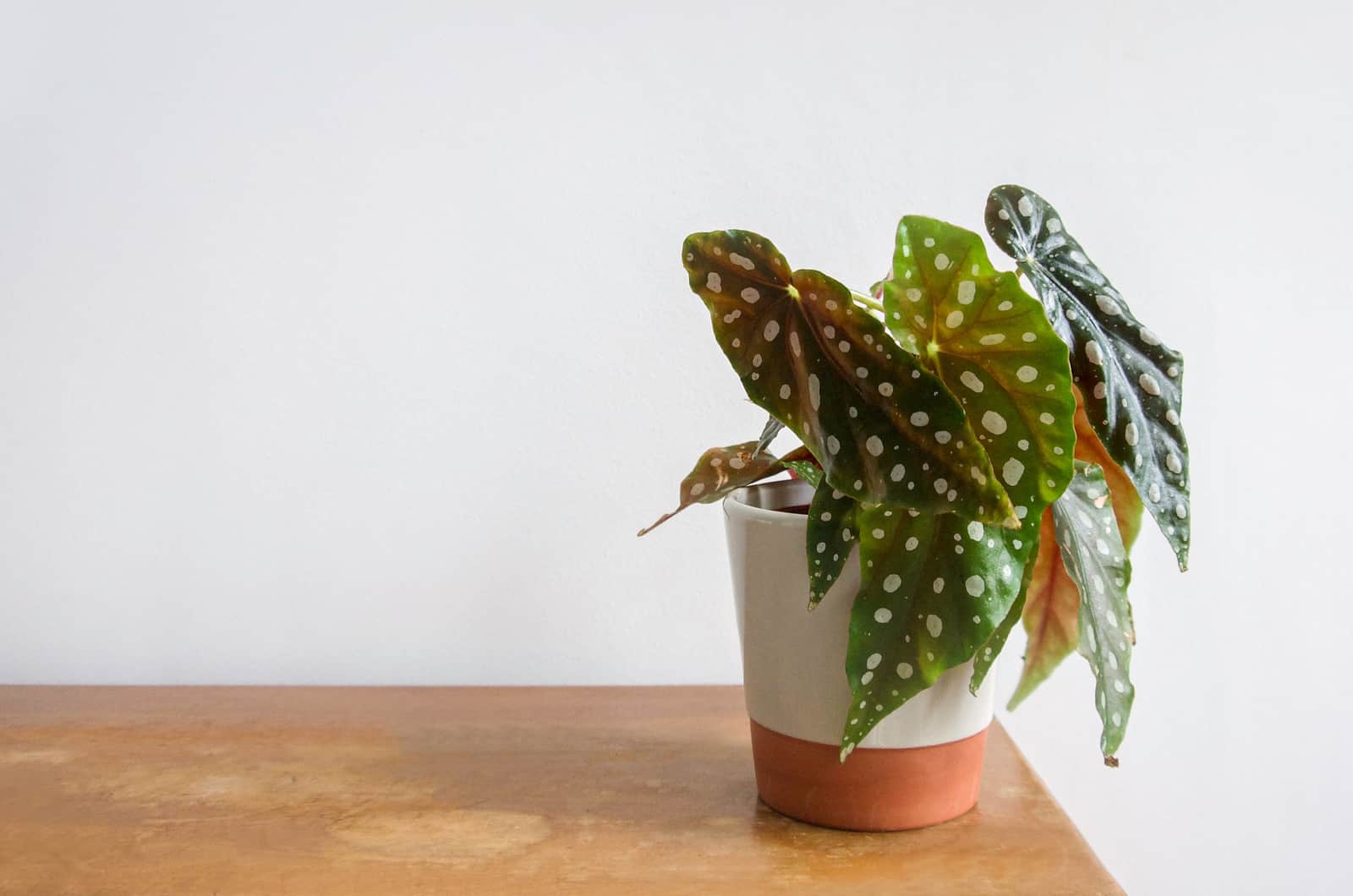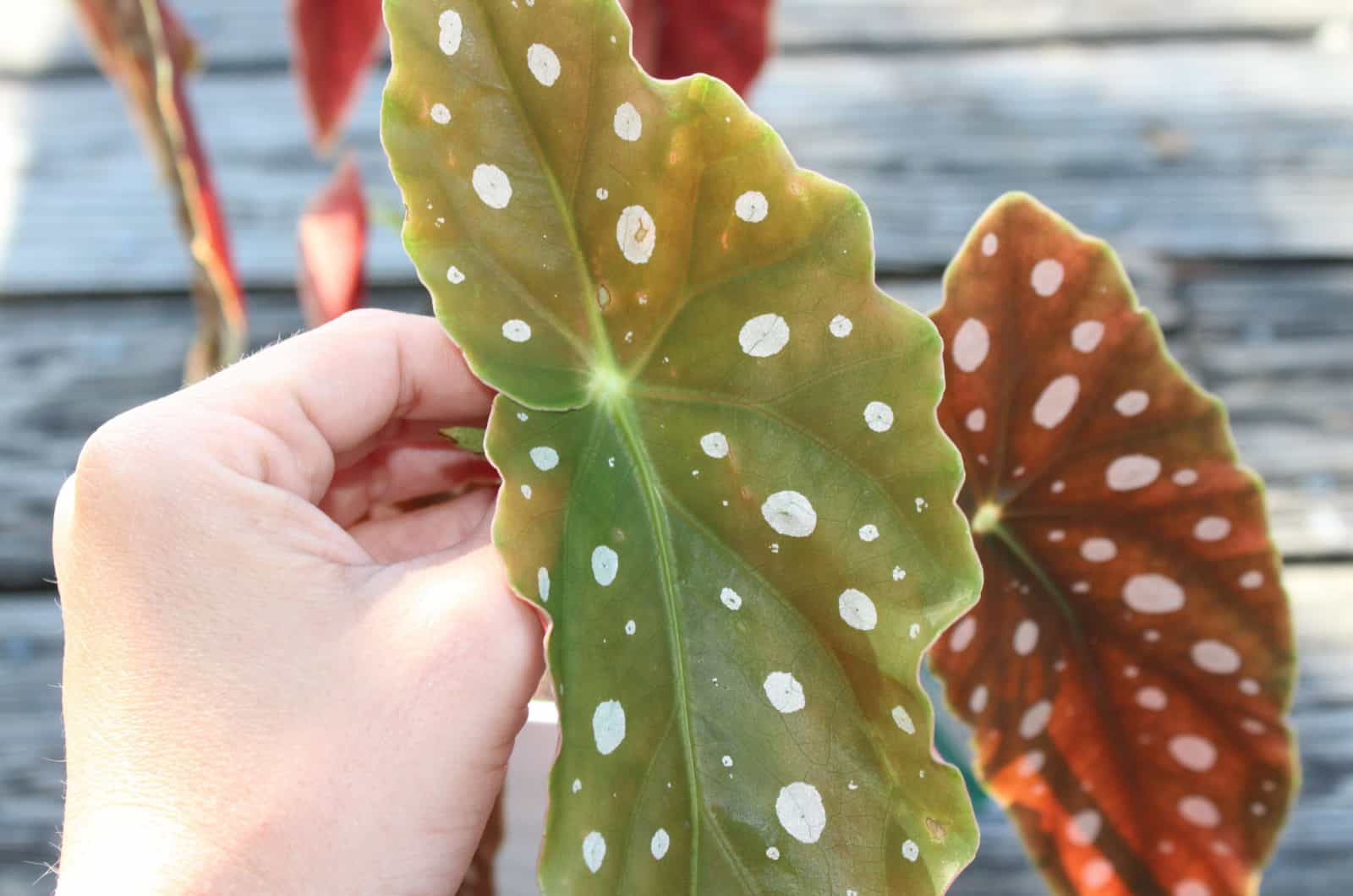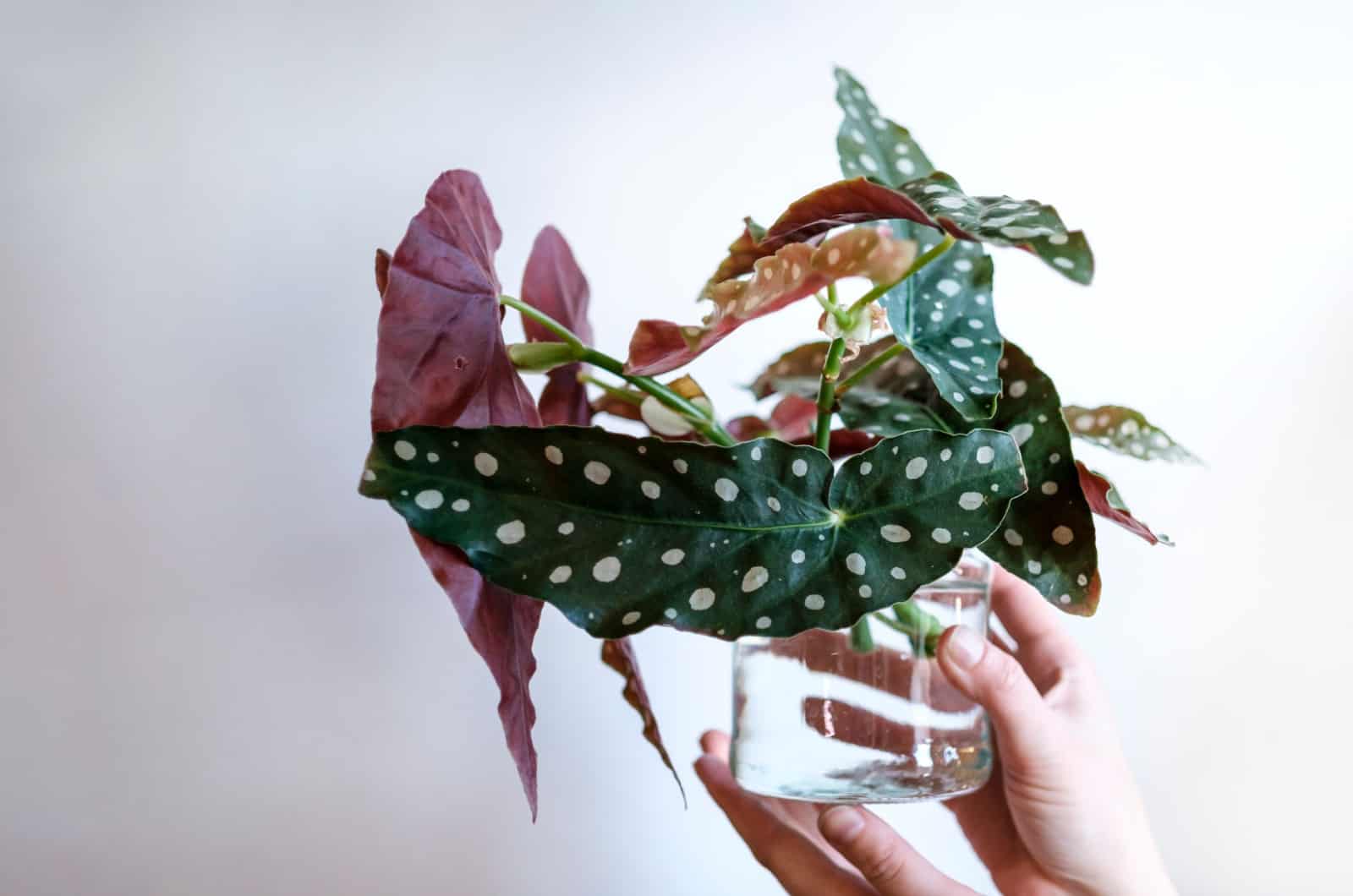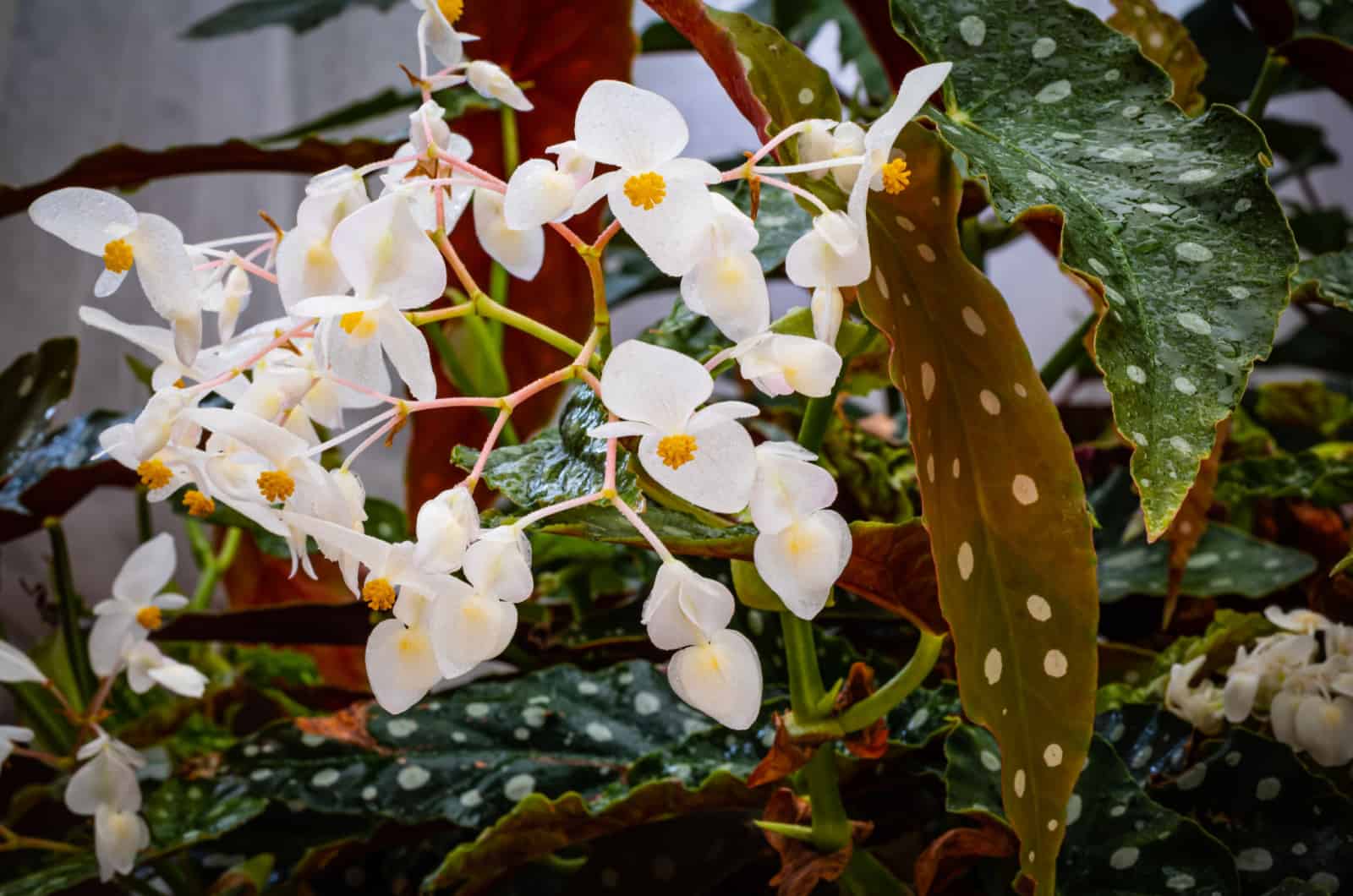When I started growing plants, most of them looked similar in color, shape, and size. I decided to look for a plant to cheer up my plant collection.
When I first saw a Begonia maculata, I needed to have one. It has now been a part of my plant collection for a while, and I’m not sure that any plant can beat it when it comes to appearance.
Polka dots aren’t usually my thing, but they look more than amazing on plant leaves.
When you add ease of care to appearance, this Begonia is one of the best plants to grow indoors.
Let’s start with some basic info about the polka dot Begonia.
[table id=438 /]
Let’s get started!
What Is Begonia Maculata?
The maculata plant is a cultivar of angel wing Begonia, also known as the cane begonia.
I’ll tell you more about the appearance of this cultivar, its size, and its growth habit, but first, I need to tell you why this plant has become so famous lately.
I’m sure you’ve seen the iconic red-soled heels from the Christian Louboutin collection. Believe it or not, Begonia maculata inspired Christian to make the shoes; I’m not into fashion much, but this designer loves plants, so I love him.
Let’s see what’s so special about the polka dot Begonia.
Scientific Background
Although this Begonia was first introduced in 1982, it’s considered a new cultivar. It’s one of the 2000 species of the genus Begonia.
All types of Begonias are indigenous to subtropical and tropical regions. Several of them, including the polka-dot Begonia and Begonia beefsteak, are now widely grown as indoor plants.
Italian scientist Giuseppe Raddi introduced the plant and named it macula because of the beautiful polka dot Begonia’s leaves; the word comes from Latin and refers to speckles or spots.
Leaves
The Begonia maculata leaves are olive green, elongated, and have the shape of angel wings, which is the main characteristic of cane Begonias.
The leaf surface features incredible silver polka dots; it looks like someone has taken a handful of silver sprinkles and put them on the magnificent leaves.
We are not done yet; the undersides of the leaves differ from the surface as they are vivid red or maroon.
No wonder this plant inspired Louboutin; I mean, just look at it.
Stems & Flowers
Maculata is also recognized by its bamboo-like stems, and this is another feature that makes this plant stand out.
Finally, the maculata produces unique red or white flowers that resemble bells.
This plant may produce flowers when grown as a houseplant, but only if you meet all of its requirements.
Don’t worry; I’ll give you some care tips later to keep your maculata healthy. I’m sure it will reward you with magnificent flowers.
Polka Dot Begonia Care Guide
Now that we know more about the appearance and background of this unique houseplant, it’s time to find out about the Begonia maculata’s care requirements.
Although this Begonia is generally considered easy to maintain, it can be fussy about humidity and soil.
But, once you learn the basics, I’m sure your maculata won’t face any issues.
Here’s an overview of maculata growth requirements.
[table id=439 /]
Let’s get into the details!
Light Requirements
When it comes to the light requirements of this Begonia plant, you should aim for a spot with bright indirect light.
First, let’s discuss why you shouldn’t expose your maculata to direct sunlight. Plants from the Begonia genus originally grew in tropical regions.
However, they aren’t tall, and their leaves weren’t exposed to direct sun because taller tropical trees have dense foliage and protected the Begonias from the direct sun.
Instead of direct sun rays, the breathtaking maculata’s silver-spotted leaves received filtered, indirect sunlight.
No wonder they don’t thrive in south-facing windows during hot summer days. This light level may significantly impact the overall health of your Begonia, so make sure to avoid spots that receive too much light.
If you notice sunburn, wilting, and yellowing, consider changing the location of your maculata.
East- or west-facing windows are great choices, but if a south-facing window is the only option, just put sheer curtains up to protect the delicate maculata’s leaves.
Avoid north-facing windows because these Begonias won’t grow well in too low light. However, they may tolerate slightly lower light levels. Still, if you notice stunted growth or drooping, I recommend using grow lights. You can get them on Amazon.
Humidity Requirements
If I had to choose the trickiest part of maculata care, it would definitely be the humidity level.
Every grower with a maculata plant in their collection will tell you one thing; this Begonia plant won’t grow in low humidity.
Your plant won’t die, but it definitely won’t produce beautiful white flowers. Additionally, it could start losing leaves, and that’s definitely something we don’t want to happen.
Low humidity may lead to other problems, such as watering ones. How come? You probably know that water doesn’t evaporate fast in low humidity, but rather stays in the soil, making the plant more sensitive to fungi and bacteria.
Luckily, you can quickly fix this issue by using some easy methods for raising the humidity.
Methods For Increasing Humidity Levels
Below, you’ll find a list of effective methods for increasing humidity.
• Misting: If you are a passionate plant grower and spend a lot of time caring for your plants, then misting is an excellent method for you.
Misting won’t significantly increase the humidity unless you do it frequently. If you have enough time, mist your maculata regularly, but allow the leaves to dry well, as otherwise, they might rot.
• Place your maculata next to other houseplants: Another effective method for raising humidity is to create a microclimate, i.e. group your indoor plants. If you grow a Philodendron, put it next to your maculata.
• Move your polka dot Begonia to a more humid room: This is probably the easiest method. Just place your maculata in a bathroom or kitchen, and it will have enough humidity for optimal growth.
• Place a humidity tray below the pot: Do pebble trays work for humidity? Your maculata will certainly benefit if you place a pebble tray below its pot.
This won’t increase humidity a lot, but if combined with some of the other methods above, it will work fine.
• Use a humidifier: If you are wondering what the most reliable way to increase humidity is, the answer is a humidifier.
This device monitors and increases humidity, and your maculata plant will be destined to thrive.
Temperature Requirements
These plants may be a little bit fussy over humidity, but their temperature requirements are pretty low.
Maculatas thrive at room temperature, but their growth won’t be impacted if the temperatures are higher (up to 85 degrees Fahrenheit).
If you live in USDA hardiness zone 10, you can also grow maculatas outdoors. Be careful, though, as if the temperatures drop below 55 degrees Fahrenheit, the best option is to take your maculata indoors.
Spots near heating vents, air conditioners, and fireplaces should be avoided. This Begonia isn’t a fan of temperature fluctuations and cold drafts.
What Type Of Soil Does A Begonia Maculata Like?
Regarding the soil type, Begonia maculata requires the same potting mix as other houseplants that initially grew in tropical regions.
First, the soil needs to be well-draining, as your maculata’s biggest enemy is overwatering.
Second, the soil needs to be porous, as the air spaces ensure enough oxygen for the plant roots.
And third, the soil needs to be fertile, as your maculata needs nutrients for optimal growth.
Let’s discuss the materials that will improve the soil structure. You can purchase regular potting soil and then add different materials that aid drainage, aeration, and fertility.
One of the best materials for drainage is perlite, so I highly recommend amending the soil with it, no matter which plant you grow.
You can also add orchid bark and wood chips to the soil for air circulation.
These Begonias prefer slightly acidic to neutral soil; the pH should range from 6.1 to 7.5.
Pot size and drainage holes also play a significant role in drainage; don’t choose a too large pot because it will have too much soil and retain more water than the roots can absorb.
On the other hand, the roots need space to grow, so don’t choose too small a pot.
How To Water Polka Dot Begonia
Watering becomes a big challenge if you don’t ensure the right type of soil. Additionally, inadequate conditions may change the watering needs of maculata plants.
A rule of thumb is to keep a polka dot Begonia’s soil moist but never soggy; too much moisture might cause root rot. Also, never allow the soil to dry out entirely; a dehydrated maculata isn’t something we want.
The best approach is to wait until the topsoil is dry and then give your Begonia a good soak.
As far as the watering technique is concerned, bottom watering is frequently advised because these Begonias dislike their leaves being wet.
But, if that seems too complicated, use the top watering technique, but make sure you don’t water the leaves.
The key to a perfect watering schedule is to monitor the soil moisture content all the time. You can check moisture content by sticking your finger into maculata’s soil or using a hygrometer.
Fertilizing Schedule
Luckily, maculatas aren’t heavy feeders, and your main goal is not to overfeed them. Applying too much fertilizer may cause leaf tips and edges to turn brown.
The growing season of spotted Begonias starts in the early spring and lasts until the fall. You can apply fertilizer once or twice a month but only during the growing season.
There’s no special fertilizer for these Begonias; a balanced, liquid, all-purpose fertilizer will suffice.
Pay attention to fertilizer strength; no matter which one you use, dilute it to half strength.
How To Prune Begonia Maculata
Once maculatas are fully established, they may get too bushy and require maintenance.
The spotted Begonia prefers to focus more of its energy on growing in height rather than in width. If you don’t fix it, this may result in the canes being thin and leggy.
Cutting the cane tips promotes bushier growth by releasing a hormone that inhibits branching.
Start by snipping 1/4 of an inch above your maculata’s leaf. You can expect a new leaf to grow shortly after the snipping.
You can achieve more significant plant alteration by employing the same technique above any maculata’s leaf.
Get sharp shears and dip them into a sterilizing solution before each cut.
Repotting
Trout begonias won’t mind being slightly rootbound, but I recommend repotting them annually.
These plants may not outgrow their pot after a year, but they’ll definitely need new nutrients.
When purchasing a new pot, choose heavier ones, these Begonias may be top-heavy.
I recommend terracotta pots, not only because of their weight but also due to their porosity.
If your Begonia has overgrown its pot, make sure the new pot isn’t more than 2 inches larger in diameter.
When taking your maculata out of the pot, don’t pull it, just lean its pot to one side, tap on it gently, and the plant will slide out.
Water your trout Begonia immediately after repotting to avoid shock.
How To Propagate A Begonia Maculata Plant
Maculatas are very famous plants (thank you, Mr. Louboutin) which is why many people ask how they can get more of them.
Luckily, propagating Begonia maculata plants isn’t a difficult activity, but rather fun, and it gives great results in most cases.
There are plenty of plant propagation methods, and you can choose between four for this plant; I’m sure you’ll find one for yourself, whether you are a beginner or a master gardener.
Leaf Cuttings
The first method for getting new maculatas is through leaf cuttings. Make sure your shears are sharp enough, and don’t forget to sterilize them before each cut.
Before cutting the leaf, ensure it’s completely healthy and has a petiole.
After cutting the leaf, it’s time to root it. You can use plastic nursery pots from Amazon and fill them with a potting mix that consists of the materials I discussed above.
Put the petiole in the potting mix and cover the pot with a plastic bag.
Your cuttings need a lot of bright indirect light and moisture to develop roots.
Stem Cuttings
Another excellent propagation method for maculata plants is stem cuttings.
You’ll need a healthy stem cutting, a new potting mix, and a transparent jar if you decide on water propagation.
You can only use the parts of the stem with nodes, as the new roots will sprout from these plant parts.
I’ll tell you more about soil propagation first. Fill the nursery pot with a proper potting mix and make a tiny hole in the center.
When inserting the cutting, be extra careful as it will be pretty delicate, and you won’t need much force to destroy it.
Also, pay attention to the position of the nodes; at least one should be below the soil line. Ensure enough light and humidity, and repot to a bigger pot once the roots have developed.
If you are rooting maculata cuttings in water, refresh the water in the jar every three days. If you notice any bad smells, take the cutting out and inspect it.
Once the cutting has formed new roots, transplant the cutting into the potting mix; be careful, water roots are even more delicate than ones formed in soil.
Propagating From Seeds
If you have been propagating and like challenges, you can try propagating your maculata using seeds.
This technique is time-consuming and demands skills, so I don’t recommend it to beginner growers.
The biggest issue is that you won’t know if the seeds are from hybrid Begonias. It often happens that a grower does not only get an identical copy but a completely different Begonia.
There’s also the possibility that the seeds are sterile, so you won’t get new plants at all.
However, if you decide to collect seeds from your Begonia, you can cut the stems after the plant is done flowering.
You can also collect the seeds when the flowers are dry.
Division
The last method I’ll show you refers to dividing many maculata stems and offshoots.
First, you need to remove your spotted Begonia from its pot and untangle any odd roots.
Inspect the root system closely and if you notice some diseased roots, remove them with sanitized shears.
You can also use shears when dividing your trout Begonia plant.
After division, put the parent plant back into the pot and put each divided section into a separate pot. Never re-use the previous plant’s soil mix because it may be contaminated and seriously harm your new plants.
Resume with your usual polka dot Begonia plant care.
Common Issues
Your maculata may face typical houseplant issues, this includes pests, diseases, and also issues related to inadequate care.
Let’s get into the details!
Pests
Naughty little creatures have been giving nightmares to growers since forever. Mealybugs and whiteflies are most commonly found on maculata leaves.
You should do everything to prevent infestation, but if some pests occur, there are a couple of methods you can use to remove them.
You can control pests during flowering using a few efficient and inexpensive methods, such as rubbing alcohol, neem oil, horticultural oils, or insecticides.
I recommend rubbing plant leaves with neem oil regularly to repel pests.
Diseases
Here is a list of diseases that may affect maculata plants, what can cause them, and how to fix them.
Botrytis: You should check for botrytis if you notice brown and mushy spots on trout Begonia leaves, especially on the ones closer to the plant base. The humidity level is most likely too high.
Sterilize your cutting tools (the most important step), cut off any leaves on your Begonia with brown spots, and spray with fungicide.
Powdery mildew: Powdery mildew is another fungal disease that thrives in wet and humid conditions. If there are some white powdery spots on the leaves of your trout Begonia, check for this disease.
Remove the infected maculata leaves and apply a fungicide.
Root rot: Black or brown spots, yellow or brown leaves, mushy soil, and discolored roots are all signs of root rot. The most common cause of this lethal plant disease is overwatering.
If you conclude that your Begonia maculata is suffering from root rot, you’ll need to remove it from the container and cut all the diseased roots off using sanitized shears.
Bacterial leaf spot: If you notice water-soaked blotches on the maculata’s leaves, you should check for bacterial leaf spot disease. Again, overwatering is most likely the culprit.
Take your shears, sanitize them, and cut off all infected leaves on your maculata plant. If the infection is severe and blotches are all over the plant, you’ll need to dispose of your Begonia.
Leaves Turning Yellow
The maculata’s leaves are most likely to turn yellow if the soil has too much moisture.
However, inadequate light levels and underwatering may also be the cause of yellowing.
Check the light and the soil moisture; if the soil is mushy, your maculata needs to come out of the pot for further examination.
Wilting
If your Begonia maculata is wilting and has curly or crispy leaves, it’s most likely dehydrated.
However, root rot, too high humidity, and too much light may also be the reason for wilting, so make sure you check everything.
FAQs
Is the Begonia maculata rare?
Begonia maculata or polka dot Begonia is not rare. If you can’t find it on the plant store shelves, remember that many want these plants due to their connection to Christian Louboutin. These plants are easy to propagate; if you can’t find them in the plant store, I’m sure they’ll be available online.
Is Begonia maculata toxic?
According to ASPCA, Begonia maculata is a toxic plant due to the calcium oxalate crystals found in the plant leaves. If you have toddlers or pets, please keep your maculata out of reach.
What is the best time of year to plant a Begonia maculata?
Spring is the best time to plant, repot, and propagate a Begonia maculata. Your Begonia is resting during the winter and continues growing once the spring arrives. It will quickly recover from any activity and be less susceptible to stress.
What is the lifespan of a Begonia maculata?
Begonia maculata is a perennial plant; if you meet all its requirements, it can adorn your household for 3–4 years.
Wrapping Up
If you are looking for a plant that will leave everyone breathless, a Begonia maculata is perfect for you. I mean, it left Christian Louboutin speechless.
Although polka dot Begonia may be fussy over humidity and soil, it’s generally considered a low-maintenance plant.
I strongly agree, and once you learn the basics and provide it with proper care, the iconic silver-spotted leaves will shine and adorn any room.
But remember that the maculata is a toxic plant, so place it where small children or pets can’t reach it.
Until next time!
Like this post? Share or pin it for later!







